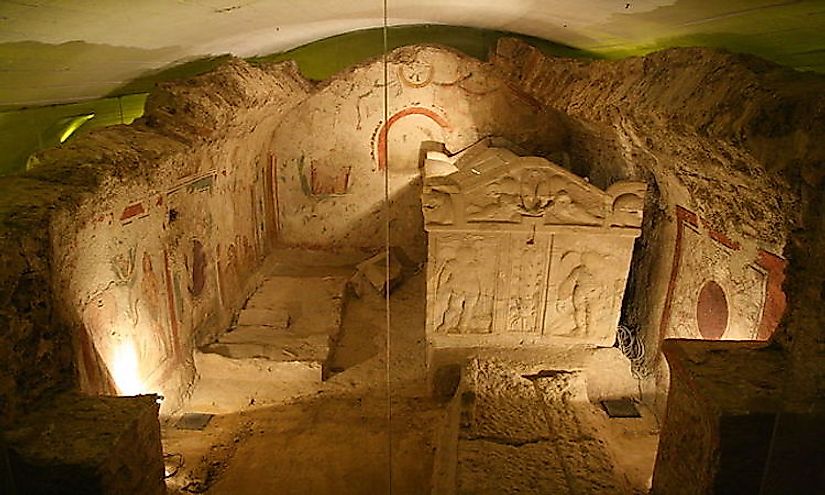UNESCO World Heritage Sites In Hungary

Hungary is a country that is located in Central Europe and is landlocked. Hungary accepted the “Convention Concerning the Protection of the World Cultural and Natural Heritage“ in 1985, a decade after it had originally come into force. Hungary currently has eight United Nations Educational, Scientific and Cultural Organization (UNESCO) World Heritage Sites, seven that are cultural and one that is natural. Hungary's first two sites were designated in 1987, with the most recent site being designated in 2002.
Hungary's UNESCO World Heritage Sites
Aggtelek Karst and Slovak Karst Caves
The Aggtelek Karst and Slovak Karst Caves was designated as a UNESCO World Heritage site in 1995 and is currently the only natural UNESCO site in Hungary. The Aggtelek Karst and Slovak Karst Caves site sit on the border that the northeastern part of Hungary shares with southeastern Slovakia and is located in both countries. The site is made up of over 1,000 different caves that cover an area about the size of 218 square miles (564 square kilometers). The site is notable for being a mostly intact, diverse and complex system of numerous caves that have provided an array of diverse structures and habitats that are important for biological, geological and paleontological studies. The site has also led to the find of various sediments and fossils that have given scientists a lot of evidence that there were subtropical and tropical climatic conditions during the Late Cretaceous and early Tertiary periods.
Pécs (Sopianae) Early Christian Necropolis
The Early Christian Necropolis of Pécs was designated as a UNESCO World Heritage site in 2000. The necropolis is located in the County of Baranya in the town of Pécs. The necropolis was built in the 4th century in the cemetery of the town of Sopianae (now Pécs), a town that was part of the Province of Pannonia in the Roman Empire. This necropolis has underground burial chambers and also has memorial chapels above ground to mark the site. The ruins of the necropolis are made up of chapels, burial chambers and a mausoleum that makes up arguably the most magnificent collection of structural types of monument tomb in any of the northern or western Roman provinces. The tombs at the site are lavishly decorated with an amazing quality to the Christian-themed murals on them and also reflect a diversity of various cultural sources. The site was discovered and has been excavated by archaeologists for around two centuries, who look towards its important to understand early Christian monuments, art and growth for the period.
Tokaj Wine Region Historic Cultural Landscape
The Tokaj Wine Region Historic Cultural Landscape was designated as a UNESCO World Heritage site in 2002. The Tokaj Wine is located in the county of Borsod-Abaúj-Zemplén in the northeast part of the country at the foothills of the Zemplén Mountains sitting right along the Bodrog River. The Tokaj Wine Region covers a total of 27 different settlements of a landscape that reflects the region's living tradition and culture of wine production. It is known that grapes have been grown and cultivated in the region since 1561 to make the famous Tokaji wines. The site is also notable since it was one of the first wine regions to have a legal base of delimitation when the Holy Roman Emperor Charles VI (1685-1740) established the area as a closed wine region in 1737. The site is also notable for is historic networks of deep wine cellars, as well as the intricate patterns and historically value of its vineyards, villages and small towns that reflect the distinct viticultural tradition of the region.
The Integrity And Threats To Hungary's UNESCO World Heritage Sites
The Aggtelek Karst and Slovak Karst Caves site is very well preserved and nearly completely preserved in its original natural condition. Only about 1% of the caves have been significantly changed to allow them to be seen by tourists. The biggest threat to the caves and their integrity is from surface activities that must be strictly controlled for the caves to not be affected by deforestation, soil erosion or agricultural pollution which could all affect the water quality and soil in the caves.
Since the Early Christian Necropolis of Pécs started being excavated about two centuries ago, the site has been preserved at its original location and has also been restored over time while having its original form conserved and still present. The site currently faces no major threats to its integrity, however, management plants must be reviewed often to monitor and continue preserving the site. The properties at the Tokaj Wine Region Historic site have kept their original level of authenticity of the years, and the overall appearance of the area has stayed unchanged. There are not real short-term threats to the integrity of the site, but in the long term the site's integrity could be affected by climate change, the disappearance of nearby wetlands and the expansion of current built-in areas.
UNESCO World Heritage Sites In Hungary
| UNESCO World Heritage Sites in Hungary | Year of Inscription; Type |
| Aggtelek Karst and Slovak Karst Caves | 1995; Natural |
| Budapest Historic City along the Banks of the Danube, Buda Castle Quarter, and Andrássy Avenue | 1987; Cultural |
| Fertö-Neusiedlersee Cultural Landscape | 2001; Cultural |
| Hollókő Old Village and Surroundings | 1987; Cultural |
| Pannonhalma Millenary Benedictine Abbey and its Natural Environment | 1996; Cultural |
| Pécs (Sopianae) Early Christian Necropolis | 2000; Cultural |
| Puszta and Hortobágy National Park | 1999; Cultural |
| Tokaj Wine Region Historic Cultural Landscape | 2002; Cultural |











